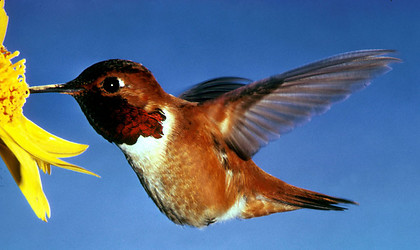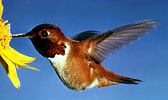Apodiformes
Hummingbirds and Swifts



This tree diagram shows the relationships between several groups of organisms.
The root of the current tree connects the organisms featured in this tree to their containing group and the rest of the Tree of Life. The basal branching point in the tree represents the ancestor of the other groups in the tree. This ancestor diversified over time into several descendent subgroups, which are represented as internal nodes and terminal taxa to the right.

You can click on the root to travel down the Tree of Life all the way to the root of all Life, and you can click on the names of descendent subgroups to travel up the Tree of Life all the way to individual species.
For more information on ToL tree formatting, please see Interpreting the Tree or Classification. To learn more about phylogenetic trees, please visit our Phylogenetic Biology pages.
close boxReferences
Chantler, P. 2000. Swifts: A Guide to the Swifts and Treeswifts of the World. 2nd ed. Yale University Press, New Haven.
Chubb, A. L. 2004. Nuclear corroboration of DNA-DNA hybridization in deep phylogenies of hummingbirds, swifts, and passerines: The phylogenetic utility of ZENK (ii). Molecular Phylogenetics and Evolution 30 (1): 128-139.
Cracraft, J., F. Keith Barker, M. J. Braun, J. Harshman, G. Dyke, J. Feinstein, S. Stanley, A. Cibois, P. Schikler, P. Beresford, J. García-Moreno, M. D. Sorenson, T. Yuri, and D. P. Mindell. 2004. Phylogenetic Relationships Among Modern Birds (Neornithes): Toward an Avian Tree of Life. Pp 468-489 in Cracraft, J. and M. J. Donoghue (eds.), Assembling the Tree of Life. Oxford University Press, New York.
Johansson, U. S., Parsons, T. J., Irestedt, M. and Ericson, P. G. P. 2001. Clades within the "higher land birds", evaluated by nuclear DNA sequences. Journal of Zoological Systematics and Evolutionary Research 39: 37-51.
Lee, P. L. M., D. H. Clayton, R. Griffiths, and R. D. M. Page. 1996. Does behavior reflect phylogeny in swiftlets (Aves: Apodidae)? A test using cytochrome b mitochondrial DNA sequences. Proceedings of the National Academy of Sciences of the United States of America 93 (14): 7091-7096.
Mayr, G. 2002. Osteological evidence for paraphyly of the avian order Caprimulgiformes (nightjars and allies). Journal Fur Ornithologie 143 (1): 82-97.
Mayr, G. 2003. Phylogeny of early Tertiary swifts and hummingbirds. Auk 120 (1): 145-151.
Price, J. J., K. P. Johnson, and D. H. Clayton. 2004. The evolution of echolocation in swiftlets. Journal of Avian Biology 35 (2): 135-143.
Sibley, C. G., and J. E. Ahlquist. 1990. Swifts and Hummingbirds. Pages 391-401 in: Phylogeny and classification of birds: a study in molecular evolution. Yale University Press, New Haven.
Title Illustrations

| Scientific Name | Selasphorus rufus |
|---|---|
| Comments | Rufous Hummingbird |
| Creator | Dean E. Biggins |
| Specimen Condition | Live Specimen |
| Source Collection | U.S. Fish and Wildlife Service Online Digital Media Library |
About This Page
Page copyright © 2008
 Page: Tree of Life
Apodiformes. Hummingbirds and Swifts.
The TEXT of this page is licensed under the
Creative Commons Attribution-NonCommercial License - Version 3.0. Note that images and other media
featured on this page are each governed by their own license, and they may or may not be available
for reuse. Click on an image or a media link to access the media data window, which provides the
relevant licensing information. For the general terms and conditions of ToL material reuse and
redistribution, please see the Tree of Life Copyright
Policies.
Page: Tree of Life
Apodiformes. Hummingbirds and Swifts.
The TEXT of this page is licensed under the
Creative Commons Attribution-NonCommercial License - Version 3.0. Note that images and other media
featured on this page are each governed by their own license, and they may or may not be available
for reuse. Click on an image or a media link to access the media data window, which provides the
relevant licensing information. For the general terms and conditions of ToL material reuse and
redistribution, please see the Tree of Life Copyright
Policies.
- First online 14 December 2005
Citing this page:
Tree of Life Web Project. 2005. Apodiformes. Hummingbirds and Swifts. Version 14 December 2005 (temporary). http://tolweb.org/Apodiformes/26391/2005.12.14 in The Tree of Life Web Project, http://tolweb.org/







 Go to quick links
Go to quick search
Go to navigation for this section of the ToL site
Go to detailed links for the ToL site
Go to quick links
Go to quick search
Go to navigation for this section of the ToL site
Go to detailed links for the ToL site